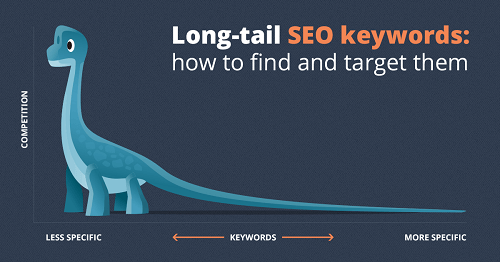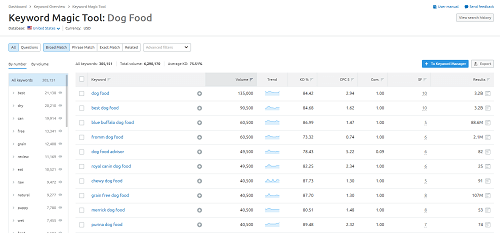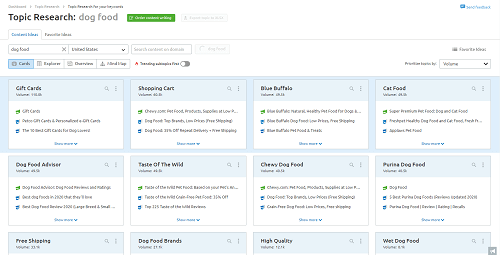How to Choose the Right Long Tail Keywords
Long Tail keywords are an essential part of ranking well on search engines. But what exactly are long tail keywords, and how do you find them? In addition to this, once you have your list of long tail keywords, how do you use them effectively? We’ll take you through what they are, as well as how to best use them.

What Are Long Tail Keywords?
We all want to rank for the most popular keywords, but these keywords are the most popular for a reason. They have the highest search volume, but they have the highest competition. Everyone is trying to rank for these generic search terms, sometimes also called head keywords. This is where long tail keywords come into play.
These are more specific keywords that have lower search volumes. Typically, long tail keywords are made up of three or more words, but this is not always the case. As these have lower search volumes, they are ideal for new sites to target.
Let’s give you a practical example. Let’s say you want to rank for ‘Dog food’. In your market, this may have a monthly search volume of say 100 000. However, if you choose a long tail variant, like ‘Best Dog Food’ or ‘Most Nutritious Dog Food’, you will find the search volume is much lower. It would be very difficult to rank for ‘Dog Food’, but those other two will be much easier to rank for.
Why Target Long Tail Keywords?
So, why should you target long tail keywords? There are a number of reasons it is a good idea to target. We’ve laid them out below.
- Much Easier to Rank For – The first thing that makes long tail keywords ideal to target is the lower competition. Yes, the search volumes are lower, but this is what makes them ideal. With the lower search volumes, fewer competitors are going to be optimising their page for that keyword.
- More Targeted Audience – The other good thing about long tail keywords is that you’ll find a more targeted audience. The user who is searching for a long tail keyword already knows what they are looking for. They simply need to find a website to supply what they need.
- Cheaper Advertising – Finally, another good reason to target long tail keywords is that they are significantly cheaper to advertise with. The higher the search volume, the more it will cost to advertise with that term. This means you can stretch your budget much further with long tail keywords.
How Do You Find Long Tail Keywords?
So, we’ve convinced you that you should go after long tail keywords, how do you go about finding them? There is no single rule or formula for how to find long tail keywords. It is up to the writer to do the research and find the keywords they want to go after. The good news is that there are plenty of tools out there that will make this easier.
We will be looking through several of these tools we like to use, as well as giving you some other ideas to get long tail keywords without needing to use tools.
Keyword Magic – Semrush
The first tool we recommend is Keyword Magic from Semrush. This tool is really simple and easy to use and will give you plenty of keyword ideas. All you need to do is put in your most generic keyword your page is targeting, then input the country your site is targeting. Once you have a list of keywords, there are several options like phrase match, broad match, exact match, and related keywords. This will give you plenty of keyword options for your page.

Topic Research – Semrush
Another amazing Semrush Tool is Topic Research. Once again, you need to put in your generic keyword and location, and then it will look at the top competitors. It will then generate a range of topic cards. These cards not only give you some keyword ideas, but also tell you what relevant topics you should cover on the page.
The tool will also give you top questions related to that keyword, as well as Google related searches. The great thing about the topic research tool is that it collects a lot of the information you should normally be collecting, but it does it all automatically and in one place. Finally, you can use these topic cards to also come up with content ideas for other pages to write for your site further down the line.

Other Methods for Finding
There are several other methods to find long tail keywords. These are as follows:
- Auto Complete on Google – The first way for writers to find long tail keywords is to use Google’s Auto Complete feature. Put in your main keyword on Google and see what keywords appear in the dropdown.
- Google’s Related Searches – Once you have searched for your main keyword, you can also look at the bottom of the page and see what related searched
- io – Another tool you can use. Put in your target keyword and location, and it will give you a wide selection of related keywords to target. The tool is free to use, but it doesn’t give you all the information, like search volume. But, it is still useful to get a good selection of keywords to target.

How to Effectively Use Long Tail Keywords
So, now that you have managed to create a list of great keywords to target, what is the most effective way to use them?
- Always Keep the User in Mind – Always keep the user in mind and put yourself in their shoes. If they are searching for a particular keyword, what are they hoping to find by searching for this term? Try to make sure your content is answering their query.
- Use the keyword in a Natural Way – Gone are the days of just shoehorning a keyword into your content. We need to make sure our content reads well. Some long tail keywords may require some additional creativity to make the keywords read well. You can do this by using punctuation, or slightly tweaking the keyword. Google is smart enough to still know what you’re talking about, even if you’ve changed the keyword slightly.


